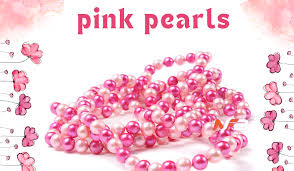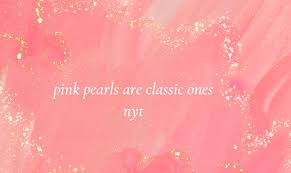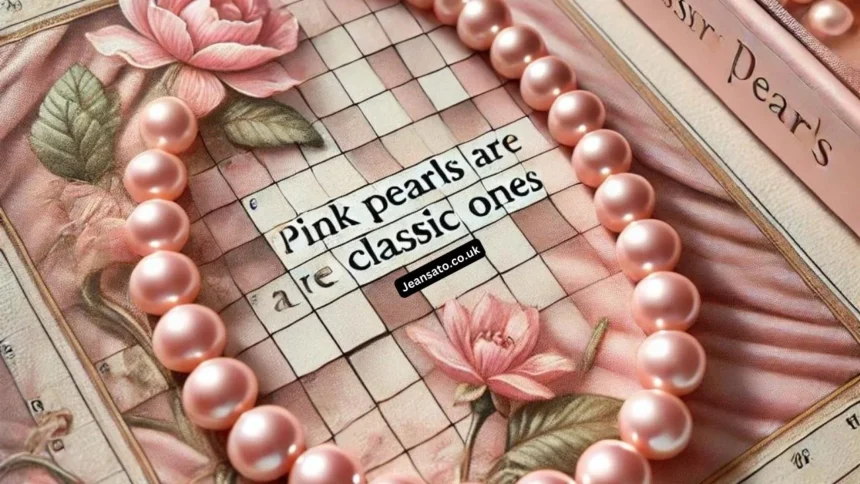Introduction
When it comes to timeless elegance in jewelry, pearls have always held a special place. Among the myriad of colors and types, pink pearls stand out as a symbol of subtle sophistication and classic beauty. Whether adorning the necks of royalty or making a statement on the red carpet, pink pearls have become synonymous with luxury and grace. In this article, we’ll explore why pink pearls are classic ones nyt, their history, and how they continue to influence modern fashion.
The Timeless Appeal of Pearls
Pearls have been treasured for centuries, and their allure shows no signs of waning. Unlike other gemstones, pearls are organic, created within living mollusks, which adds to their unique charm. The soft glow and iridescent sheen of pearls make them a versatile accessory that complements a wide range of styles and occasions. But what makes pink pearls so special?
What Makes Pink Pearls Special?
Pink pearls are rare and possess a gentle blush that sets them apart from the more common white and cream-colored pearls. This soft pink hue is often associated with femininity, romance, and elegance. The rarity of naturally occurring pink pearls further adds to their appeal, making them a sought-after choice for those looking to add a touch of classic sophistication to their jewelry collection.
History of Pearls in Jewelry
Ancient Civilizations and the Significance of Pearls
The history of pearls dates back thousands of years, with ancient civilizations like the Egyptians, Greeks, and Romans placing immense value on these lustrous gems. Pearls were considered symbols of wealth and status, often worn by royalty and the elite. In many cultures, pearls were also believed to have magical properties, offering protection and good fortune to those who wore them.
The Evolution of Pearls in Fashion
Over the centuries, pearls have maintained their status as a staple in fashion. From the elaborate pearl necklaces of the Renaissance to the simple yet elegant strands popularized by icons like Audrey Hepburn, pearls have continuously evolved with the times. Today, they are still considered a timeless addition to any jewelry collection.
Pink Pearls Through the Ages
While white pearls have always been the most common and widely recognized, pink pearls have also held a place in history. Often associated with love and romance, pink pearls were particularly popular during the Victorian era, where they were used in engagement rings and romantic gifts. Their delicate hue made them a favorite among those looking to express their affection in a subtle and elegant way.
The Formation of Pearls
How Pearls Are Created
Pearls are formed within mollusks, such as oysters and mussels, when an irritant, usually a grain of sand, becomes trapped inside the shell. The mollusk secretes layers of nacre around the irritant, which over time, forms a pearl. This natural process can take several years, with the resulting pearl varying in size, shape, and color.
Natural vs. Cultured Pearls
While natural pearls are formed without any human intervention, cultured pearls are created by deliberately introducing an irritant into the mollusk. This process, pioneered by Kokichi Mikimoto in the early 20th century, revolutionized the pearl industry, making pearls more accessible and affordable. Both natural and cultured pearls can come in a variety of colors, including the sought-after pink.
The Unique Process of Pink Pearl Formation
The formation of pink pearls is similar to that of other pearls, but their color is influenced by several factors, including the species of mollusk, the environment in which they are formed, and the thickness of the nacre. The pink hue can range from a soft blush to a deep rose, with each shade offering its own unique charm.

Types of Pink Pearls
Akoya Pink Pearls
Akoya pearls are among the most famous and highly regarded types of pearls, known for their round shape and high luster. While they are most commonly white or cream, Akoya oysters can also produce stunning pink pearls. These pearls are often smaller in size but highly valued for their exceptional quality.
Freshwater Pink Pearls
Freshwater pearls are formed in rivers and lakes, primarily in China, and are known for their wide range of colors, including pink. These pearls are generally more affordable than saltwater pearls but can still offer beautiful luster and color, making them a popular choice for those looking to add pink pearls to their collection.
South Sea Pink Pearls
South Sea pearls are known for their large size and luxurious luster. While they are typically white or golden, some South Sea oysters can produce exquisite pink pearls. These pearls are among the rarest and most valuable, often used in high-end jewelry pieces.
The Value of Pink Pearls
Factors That Determine the Value of Pearls
Several factors influence the value of pearls, including size, shape, color, luster, and surface quality. Pink pearls, in particular, are valued for their rarity and the evenness of their color. The more uniform and vibrant the pink hue, the higher the pearl’s value.
How Pink Pearls Are Priced
Pink pearls are often priced higher than their white counterparts due to their rarity. The price can vary depending on the type of pearl, with South Sea pink pearls commanding the highest prices. Additionally, factors like luster, surface quality, and size also play a role in determining the final price of pink pearls.
Pink Pearls in the Market
The demand for pink pearls has grown steadily over the years, with more consumers appreciating their unique beauty and classic appeal. As a result, pink pearls are increasingly featured in high-end jewelry collections, making them a valuable investment for those looking to add a touch of luxury to their wardrobe.
Pink Pearls in Modern Jewelry
Popular Pink Pearl Jewelry Designs
Pink pearls are incredibly versatile and can be found in a variety of jewelry designs, from classic necklaces and earrings to modern bracelets and rings. Designers often pair pink pearls with diamonds, rose gold, or other gemstones to enhance their beauty and create pieces that are both timeless and contemporary.

Celebrity Endorsements and Pink Pearls
Celebrities have played a significant role in popularizing pink pearls, often seen wearing them at red carpet events and in fashion magazines. Icons like Angelina Jolie, Scarlett Johansson, and Taylor Swift have all been spotted wearing pink pearls, further cementing their status as a classic choice in jewelry.
The Versatility of Pink Pearls in Fashion
One of the reasons pink pearls are considered a classic is their versatility. They can be worn with both formal and casual outfits, adding a touch of elegance to any look. Whether paired with a little black dress or a simple blouse, pink pearls have the ability to elevate any ensemble.
Caring for Pink Pearls
Proper Storage and Handling
To maintain the luster and beauty of pink pearls, it’s important to store them properly. Pearls should be kept in a soft cloth or pouch to prevent scratches, and away from direct sunlight or extreme temperatures, which can damage their nacre.
Cleaning and Maintenance Tips
Cleaning pink pearls should be done with care. Avoid using harsh chemicals or abrasive materials, as these can harm the pearl’s surface. Instead, use a soft, damp cloth to gently wipe away any dirt or oils, and allow the pearls to air dry before storing them.
Protecting Pink Pearls from Damage
Pearls are delicate and can be easily damaged if not handled properly. It’s important to avoid exposing them to perfumes, hairspray, or makeup, as these substances can dull their shine. Additionally, pearls should be the last thing you put on when dressing and the first thing you take off at the end of the day.
Why Pink Pearls Are Considered Classic
The Elegance of Pink Pearls
The soft, romantic hue of pink pearls has made them a favorite among those looking for a classic yet unique piece of jewelry. Their elegance lies in their simplicity, offering a subtle pop of color that can enhance any outfit without overpowering it.
Pink Pearls in Historical and Modern Contexts
Throughout history, pink pearls have been associated with love, romance, and femininity. This association has carried into modern times, with pink pearls continuing to be a popular choice for bridal jewelry, gifts, and special occasions. Their enduring appeal lies in their ability to transcend trends and remain a symbol of timeless beauty.

The Enduring Popularity of Pink Pearls
Despite the ever-changing landscape of fashion, pink pearls have remained a staple in the jewelry world. Their classic appeal, combined with their rarity and unique color, ensures that they will continue to be cherished for generations to come.
Pink Pearls in Pop Culture
Iconic Moments Featuring Pink Pearls
Pink pearls have made their mark in pop culture, with several iconic moments featuring these beautiful gems. From Marilyn Monroe’s famous pink pearl necklace to Audrey Hepburn’s classic strand in “Breakfast at Tiffany’s,” pink pearls have been a part of some of the most memorable moments in fashion history.
The Influence of Media on Pink Pearl Trends
The media has played a significant role in shaping trends around pink pearls. Fashion magazines, movies, and television shows have all contributed to the growing popularity of pink pearls, showcasing their versatility and timeless appeal.
Pink Pearls in Literature and Film
Pink pearls have also found their way into literature and film, often symbolizing love, elegance, and luxury. From classic novels to modern films, pink pearls have been used as a motif to convey a sense of sophistication and grace.
Conclusion
Pink pearls are more than just a beautiful gem; they are a symbol of timeless elegance and classic sophistication. Their unique color, rarity, and versatility make them a valuable addition to any jewelry collection. Whether worn as a statement piece or a subtle accessory, pink pearls have the power to elevate any outfit and remain a cherished item for years to come.

FAQs
- What Are the Different Shades of Pink Pearls? Pink pearls come in a variety of shades, ranging from soft blush to deep rose. The specific shade can depend on the type of pearl and the environment in which it was formed.
- How Can You Tell if a Pink Pearl is Real? To determine if a pink pearl is real, look for natural imperfections on the surface, check the weight (real pearls are heavier), and perform the “tooth test” by gently rubbing the pearl against your teeth. Real pearls will feel slightly gritty.
- Are Pink Pearls More Expensive Than White Pearls? Pink pearls are often more expensive than white pearls due to their rarity. However, the price can vary depending on the type, size, and quality of the pearl.
- How Should Pink Pearls Be Stored to Maintain Their Luster? Pink pearls should be stored in a soft cloth or pouch, away from direct sunlight and extreme temperatures. Avoid storing them in airtight containers, as pearls need moisture to maintain their luster.
- What Makes Pink Pearls a Good Investment? Pink pearls are a good investment due to their rarity, timeless appeal, and increasing demand in the market. They hold their value well and can be passed down as cherished heirlooms.










